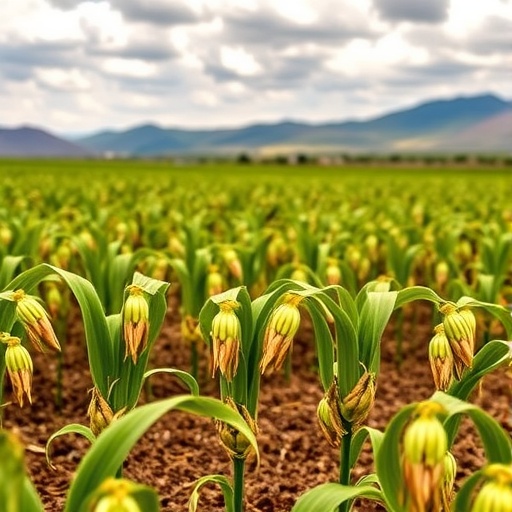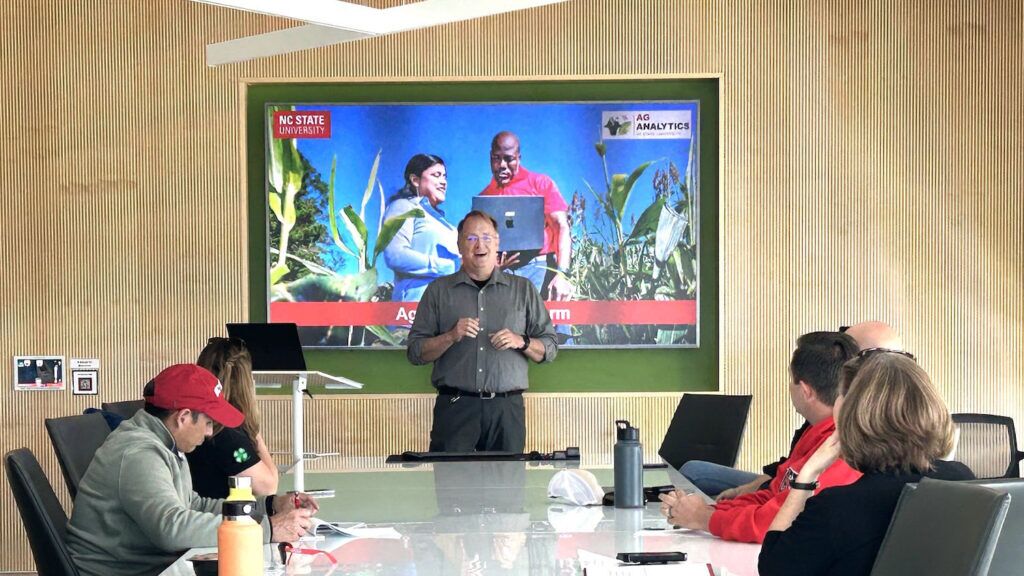Southern Africa’s Crop Yields Remain Stagnant Despite Climate Trends – bioengineer.org

Report on Stagnant Agricultural Productivity in Southern Africa and its Implications for Sustainable Development Goals
Executive Summary
A comprehensive analysis of agricultural productivity in Southern Africa over the past two decades reveals a significant stagnation in crop yields, posing a direct threat to the achievement of key Sustainable Development Goals (SDGs), particularly SDG 2 (Zero Hunger). Despite seemingly favorable climatic trends, including increased rainfall, productivity has not improved. This report examines the discrepancy between satellite data and official statistics, identifies the systemic barriers hindering progress, and proposes a multifaceted approach aligned with the 2030 Agenda for Sustainable Development to address the impending food security crisis.
1. Assessment of Cropland Productivity and Food Security
1.1 Discrepancy in Agricultural Data
Recent studies utilizing satellite data indicate that cropland productivity across Southern Africa has remained stagnant for two decades. This finding contrasts sharply with official crop statistics, which often suggest growth. This disparity highlights a critical challenge in accurately monitoring progress towards SDG 2 and underscores the need for improved data collection methodologies to inform effective policymaking.
1.2 The Productivity Paradox and Climate Trends
The region has experienced climatic conditions, such as increased rainfall, that should theoretically boost agricultural output. However, this has not translated into higher yields. This “productivity paradox” suggests that climatic factors are not the primary constraint. The failure to capitalize on these conditions jeopardizes food security and the resilience of food production systems, a core target of SDG 2.
2. Systemic Barriers to Sustainable Agriculture (SDG 1, SDG 8, SDG 10)
2.1 Socio-Economic and Structural Constraints
The stagnation is largely attributed to persistent socio-economic barriers that prevent farmers, especially smallholders, from enhancing productivity. These challenges directly impede progress on several SDGs:
- SDG 1 (No Poverty) & SDG 2 (Zero Hunger): Limited access to essential resources such as fertilizers, improved seeds, and modern agricultural technologies keeps farmers trapped in a cycle of low productivity and poverty.
- SDG 10 (Reduced Inequalities): Structural inequalities, including insecure land tenure and poor access to markets and financing, disproportionately affect smallholder farmers and prevent equitable growth in the agricultural sector.
2.2 Governance and Policy Deficiencies
The lack of an enabling policy environment is a significant obstacle. Effective governance is required to promote investment in rural infrastructure, education, and market access. Without supportive policies, the agricultural sector cannot become a driver for sustainable economic growth as envisioned in SDG 8 (Decent Work and Economic Growth).
3. A Framework for Action Aligned with the SDGs
3.1 Enhancing Innovation and Resilience (SDG 9 & SDG 13)
To overcome the current stagnation, a strategic focus on innovation and resilience is imperative. The following actions are recommended:
- Invest in Research and Development: Promote the adoption of innovative practices such as precision farming and climate-smart agriculture to enhance productivity and sustainability, contributing to SDG 9 (Industry, Innovation, and Infrastructure).
- Build Climate Resilience: Despite moderate overall trends, climate variability remains a threat. Implementing adaptive strategies is crucial for mitigating risks like droughts and unpredictable weather, directly supporting SDG 13 (Climate Action).
3.2 Strengthening Collaboration and Implementation (SDG 17)
Addressing this complex challenge requires a coordinated effort. Strengthening partnerships is essential for mobilizing resources and sharing knowledge.
- Regional and International Partnerships: Fostering collaboration among Southern African nations and with international organizations can accelerate the transfer of technology and finance, in line with SDG 17 (Partnerships for the Goals).
- Support for Smallholder Farmers: Policies and programs must be specifically designed to empower smallholder farmers, who are central to the region’s food systems and its potential for sustainable development.
4. Conclusion: An Urgent Call for Integrated Action
The stagnation of agricultural productivity in Southern Africa is a critical development challenge that threatens the well-being of millions. A business-as-usual approach is insufficient. An immediate, concerted, and multifaceted strategy is required, integrating advanced technology, supportive policies, and sustainable practices. By aligning agricultural transformation with the Sustainable Development Goals, the region can move from a state of potential crisis to one of resilience, food security, and shared prosperity.
SDGs Addressed in the Article
The following Sustainable Development Goals (SDGs) are connected to the issues discussed in the article:
- SDG 2: Zero Hunger – The article’s central theme is the “potential crisis in food security” and the “stagnation of cropland productivity” in Southern Africa, which directly relates to ensuring food security and promoting sustainable agriculture.
- SDG 1: No Poverty – The article addresses the challenges faced by “smallholder farmers” and highlights “structural inequalities, such as land ownership and access to markets,” which are critical factors in poverty alleviation.
- SDG 9: Industry, Innovation and Infrastructure – The text emphasizes the need for “investment in research and development,” “innovative agricultural practices,” “new technologies, such as precision farming,” and “investments in infrastructure” to boost productivity.
- SDG 13: Climate Action – The article discusses the impact of “climate variability,” “drought or unpredictable weather patterns,” and the need for “climate-smart agriculture” and “crop resilience” to adapt to climate change.
- SDG 17: Partnerships for the Goals – The article advocates for “Regional collaborations and partnerships” and “engaging with international organizations and stakeholders” to share knowledge, resources, and technology to tackle agricultural challenges.
Specific SDG Targets Identified
Based on the article’s content, the following specific targets can be identified:
-
SDG 2: Zero Hunger
- Target 2.3: By 2030, double the agricultural productivity and incomes of small-scale food producers.
- The article directly addresses this by focusing on the “stagnation of cropland productivity” over the past two decades and highlighting the need to support “smallholder farmers—who constitute a significant portion of the agricultural workforce.”
- Target 2.4: By 2030, ensure sustainable food production systems and implement resilient agricultural practices that increase productivity and production.
- The article calls for “climate-smart agriculture” and “sustainable practices” to enhance “crop resilience and productivity” in the face of “climate variability.”
- Target 2.a: Increase investment in, inter alia, rural infrastructure, agricultural research and extension services, technology development.
- This is a central recommendation in the article, which states that “investment in research and development is paramount” and calls for “innovative agricultural practices that harness new technologies.” It also mentions the need for “investments in infrastructure.”
- Target 2.3: By 2030, double the agricultural productivity and incomes of small-scale food producers.
-
SDG 1: No Poverty
- Target 1.4: By 2030, ensure that all men and women, in particular the poor and the vulnerable, have equal rights to economic resources, as well as access to basic services, ownership and control over land.
- The article points to “Structural inequalities, such as land ownership and access to markets” as significant barriers. It suggests that policies like “land reform and improved access to agricultural financing” are essential.
- Target 1.4: By 2030, ensure that all men and women, in particular the poor and the vulnerable, have equal rights to economic resources, as well as access to basic services, ownership and control over land.
-
SDG 9: Industry, Innovation and Infrastructure
- Target 9.5: Enhance scientific research, upgrade the technological capabilities of industrial sectors in all countries, in particular developing countries.
- The article highlights the importance of technology by discussing the use of “satellite data” for accurate assessment and advocating for “precision farming and climate-smart agriculture” as vital innovations.
- Target 9.5: Enhance scientific research, upgrade the technological capabilities of industrial sectors in all countries, in particular developing countries.
-
SDG 13: Climate Action
- Target 13.1: Strengthen resilience and adaptive capacity to climate-related hazards and natural disasters in all countries.
- The article discusses how “climate variability poses an ongoing threat” and forces farmers into “reactive strategies.” It calls for proactive measures to “enhance crop resilience” against “drought or unpredictable weather patterns.”
- Target 13.1: Strengthen resilience and adaptive capacity to climate-related hazards and natural disasters in all countries.
-
SDG 17: Partnerships for the Goals
- Target 17.6: Enhance North-South, South-South and triangular regional and international cooperation on and access to science, technology and innovation.
- The article explicitly recommends that “Regional collaborations and partnerships can further enhance efforts” by “sharing knowledge, resources, and technologies.”
- Target 17.6: Enhance North-South, South-South and triangular regional and international cooperation on and access to science, technology and innovation.
Indicators for Measuring Progress
The article mentions or implies several indicators that can be used to measure progress:
-
For SDG 2 (Zero Hunger)
- Indicator 2.3.1 (Volume of production per labour unit): The article’s primary focus is on “cropland productivity,” which is a direct measure of this indicator. The stagnation of productivity is the core problem identified.
- Indicator 2.4.1 (Proportion of agricultural area under productive and sustainable agriculture): This is implied through the call for adopting “sustainable practices,” “climate-smart agriculture,” and methods that reduce the “environmental impact of farming.” Progress could be measured by the adoption rate of these practices.
-
For SDG 1 (No Poverty)
- Proportion of farmers with secure land tenure and access to financing (related to Target 1.4): This is an implied indicator. The article suggests tracking progress on “land reform” and “improved access to agricultural financing” as essential for overcoming “structural inequalities.”
-
For SDG 9 (Industry, Innovation and Infrastructure)
- Indicator 9.5.1 (Research and development expenditure as a proportion of GDP): This is implied by the statement that “investment in research and development is paramount.” An increase in R&D spending in the agricultural sector would be a key measure of progress.
- Adoption rate of new agricultural technologies: The article’s emphasis on “precision farming,” “climate-smart agriculture,” and “satellite data” implies that tracking the adoption of these technologies by farmers is a crucial indicator of innovation uptake.
-
For SDG 13 (Climate Action)
- Number of farmers implementing resilient agricultural practices: This is an implied indicator. The article contrasts “reactive strategies” with “proactive ones that would enhance crop resilience.” Measuring the shift towards proactive, resilient farming methods would indicate progress.
-
For SDG 17 (Partnerships for the Goals)
- Number of active regional and international partnerships: The call for “Regional collaborations and partnerships” and engagement with “international organizations” implies that the number and effectiveness of such collaborations are key indicators of progress.
Summary Table: SDGs, Targets, and Indicators
| SDGs | Targets | Indicators |
|---|---|---|
| SDG 2: Zero Hunger | 2.3: Double agricultural productivity of small-scale producers. 2.4: Ensure sustainable and resilient food production systems. 2.a: Increase investment in agricultural research and technology. |
– Crop/cropland productivity levels (Directly mentioned). – Proportion of agricultural area under sustainable/resilient practices (Implied). |
| SDG 1: No Poverty | 1.4: Equal rights to economic resources, including land ownership and access to financing. | – Progress on land reform and access to agricultural financing (Implied). |
| SDG 9: Industry, Innovation and Infrastructure | 9.5: Enhance scientific research and upgrade technological capabilities. | – Investment in agricultural R&D (Implied). – Adoption rate of new technologies like precision farming (Implied). |
| SDG 13: Climate Action | 13.1: Strengthen resilience and adaptive capacity to climate-related hazards. | – Number of farms/farmers adopting climate-resilient practices (Implied). |
| SDG 17: Partnerships for the Goals | 17.6: Enhance regional and international cooperation on science, technology, and innovation. | – Number of active regional and international agricultural partnerships (Implied). |
Source: bioengineer.org
What is Your Reaction?
 Like
0
Like
0
 Dislike
0
Dislike
0
 Love
0
Love
0
 Funny
0
Funny
0
 Angry
0
Angry
0
 Sad
0
Sad
0
 Wow
0
Wow
0
















































/environment-climate-change-and-health-(ech)/water-sanitation-hygiene-and-health-(wsh)/landfill-tuvalu-36092.tmb-1200v.jpg?sfvrsn=5c21fe40_1#)

.jpg.webp?itok=0ZsAnae9#)

























